In this edition
From the Acting Director of Early Learning
Dear Families
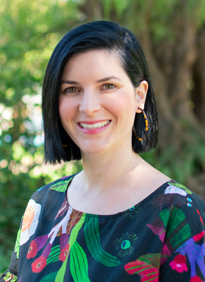
The ELC created a mission to build effective learning communities at the commencement of the year. The values that were embedded include open mindedness, optimism and respectful relationships. All of these have been pivotal in our endeavour to be truly collaborative across a community.
Our intentions were clear from the outset. We wanted to maximise all learning opportunities, creating small groups to ensure children are learning within a social construct. We wanted to offer differentiation to learning and provide children with mixed age groupings to support and enhance the varied learning styles. We also wanted our educators to collaborate and work together as this has many benefits. We are convinced that the opportunities for highly-skilled teachers to work side-by-side will also stretch their practice and provide excitement and stimulation around the learning experiences and documentation.
The ELC’s Community Garden has been the vehicle for us to see the true benefits of our new model in action as it is a shared place for learning. What began as a space has transformed into a place for our entire community. The documentation that we have across the Centre represents rich co-learning within and beyond this space. It has been a tool for possibilities, sharing an excitement around what might be planted in the future, but also for what lies beyond the infrastructure in terms of life and symbols.
What a pleasure it was yesterday to see the children’s delight in introducing their loved ones to the ELC Community Garden during our annual afternoon tea for grandparents and special friends. It was another cherished occasion for educators and families alike, and I hope you enjoy the highlights in the video below.
Kind regards
Kirsty Porplycia
Acting Director of Early Learning
(on behalf of Kate Mount)
Grandparents and Special Friends’ Afternoon Tea
This week, we welcomed grandparents and special friends for an afternoon tea to celebrate all parental figures and loved ones.
Our guests were treated to a superb spread of scones, fresh fruit and coffee as they enjoyed being shown around the children’s learning environment, making new connections and strengthening existing ones.
We also officially opened the ELC Community Garden, where children and their loved ones made special connections as they showed them around the garden and spoke of the potential things they can grow and harvest together.
Save the Date
Monday 16 – 18 September: Parent-Teacher Conversations
Friday 27 September: Term 3 ends
Monday 30 September: Vacation Care begins
Monday 7 October: Public Holiday – ELC closed
Friday 11 October: Vacation Care ends
Monday 14 October: Term 4 begins
Vacation Care Bookings
Vacation Care begins on Monday 30 September. If you require care for your child and haven’t made a booking, you can download the booking form here.
Please note that the ELC will be closed on the public holiday on Monday 7 October, and Term 4 begins on Monday 14 October.
SOL in Learning Community 2
The Symphony of Languages (SOL) Team has been supporting the ELC children to connect with the ELC Community Garden and to express their theories through the hundred languages. Watch as Learning Community 2 explores and analyses the life cycle of a caterpillar through dance, scientific drawings and collage.
Caterina Pennestri
Atelierista and Symphony of Languages (SOL) Team
ELC Immunisation Policy
Under the Government’s No Jab No Pay policy, families must meet immunisation requirements to receive the Child Care Subsidy. Further information is available from the Department of Health by clicking here.
Children with high risk conditions, as well as children who are not immunised against them, may be excluded from the ELC in accordance with the ‘Staying Healthy: Preventing infectious diseases in early childhood education and care services’ guidelines. Please refer to our Exclusion Policy for further information.
Common illnesses requiring exclusion include:
Influenza
Chicken Pox
Conjunctivitis
Diarrhoea
Hand, Foot and Mouth Disease
High Temperature
Infectious Hepatitis
Measles
Meningitis
Mumps
Rubella (German Measles)
Scabies
Scarlet Fever
School Sores (Impetigo)
Upper Respiratory Tract Infection
Vomiting
Whooping Cough
Absences in the ELC
Student Absences
Please notify the School via one of the following methods for late arrivals/early departures and absences, ensuring a reason for the absence is included.
Text: 0428 601 957 (save to phone contacts as SPGS)
Email: attendance@stpetersgirls.sa.edu.au
Phone: 8334 2200 or phone the relevant room as per the contact list
Feel free to also include the relevant room teacher when sending via email.
ELC Room Contacts:
Bell Yett – 8155 5777
Ferguson – 8155 5776
Hallett – 8155 5775
Stonyfell – 8155 5778
来自黄老师的信息
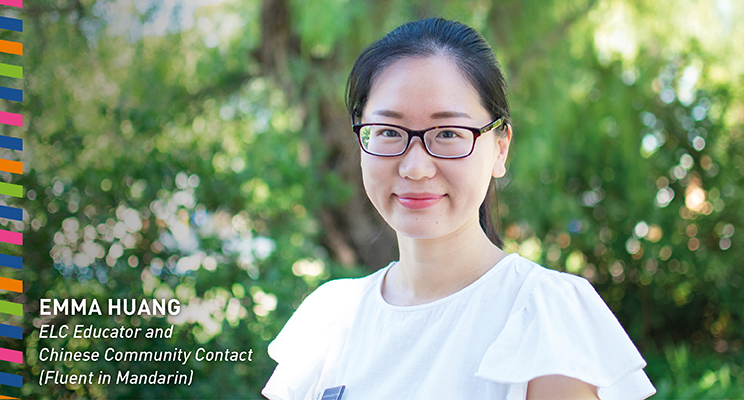
亲爱的家长朋友们,
在即将到来的一周(9月16日周一,9月17日周二,9月18日周三),是我们家长和老师的一对一交流。收到邮件的家长朋友,请尽快通过登录邮件网页链接预约同主班老师交流时间。希望家长朋友们能抽出宝贵时间参与进来。在这一次交流中,我们的老师们会和家长们一同回顾小朋友在这个学期的学习情况以及定制未来的学习目标和计划。我们老师们也很乐意为家长朋友们解答你们对小朋友学习的疑问。谈话的时间大约在15分钟。
从这周开始,我们ELC的苏老师要去休产假了,我们在这里祝愿她和小宝宝一切顺利。
Emma works in Learning Community 2 on Mondays, Thursdays and Fridays from 9am – 5pm.
Friends of the ELC Wine Fundraiser
The Friends of the ELC are holding a Wine Fundraiser with all profits going towards the new ELC Community Garden and the 2020 Artist In Residence program.
As you may be aware, the ELC Community Garden will be a key educational tool for our young students, and will assist with starting conversations about eco-systems, sustainability and our individual carbon footprint. Involving the children in the creation and maintenance of a community garden not only engages them, but also provides a rich social and environmental learning experience.
The ELC’s annual Artist In Residence program allows the children to engage and collaborate with a local artist, helping to create something for the centre and involving them in every step from the initial idea to the final development. This helps build deep connections to the centre and each other as they collaborate to achieve a common goal.
You can support our fundraising cause by purchasing premium wines at prices well below the recommended retail price. Delivery is well-timed, just a few weeks shy of the festive Summer/Christmas period. You can further support our fundraising cause by sharing the order form with your friends or relatives, who can also take advantage of the wonderful wines on offer at amazing prices.
There will be both pick-up and delivery options available and will be advised upon receipt of the order forms. You can download an order form here, and order forms will need to be returned to ELCwinefundraiser@commuserv.com.au no later than Wednesday 23 October. There is only a limited number of each of the wines available, so please complete your form and return as soon as possible to avoid disappointment.
Maria Caruso
President, Friends of the ELC
Learning Community 1
News from the Stonyfell Room
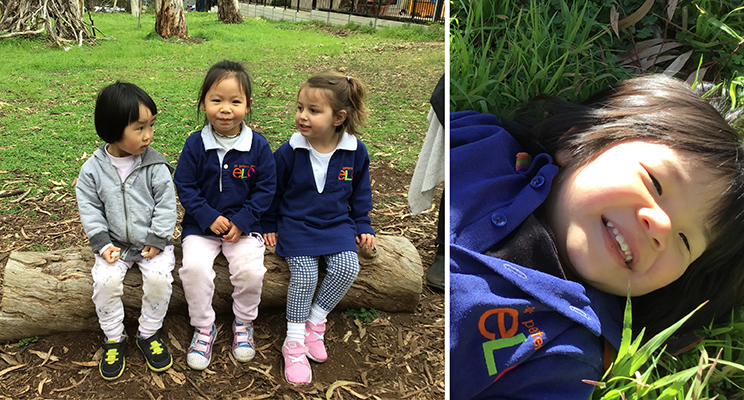
Co-constructing a Culture of Love for our Land: Living and Learning in Ferguson Park
To foster a love for place, we must engage our bodies and our hearts — as well as our minds — in a specific place.
At the time of joining our community, we tell our new families about Ferguson Park and how central this place is to our lives at the ELC. We are strongly influenced by American teacher and author Ann Pelo, who says that cultivating an ‘ecological identity’ is essential for both our wellbeing and the wellbeing of our future:
“An ecological identity allows us to experience the earth as our home ground and leaves us determined to live in honorable relationship with our planet.”
When the children and educators go into the park, it is immediately apparent that bodies, hearts and minds are instantly engaged.
We spend time:
- In a Palti Circle speaking and singing in the Kaurna language
- Climbing the logs and carrying sticks
- Exploring the Wodli
- Feeling the sap on the trees
- Looking for evidence of animals and photographing bird and insect life
All of our senses and thoughts are absorbed in what is around us. What we experience both individually and as a group has an impact on us emotionally, and the deep love for the land that we need to feel in order to look after it is provoked in us all.
Visiting and revisiting the same place means that the children notice all of the little things that may ordinarily go unnoticed in the busyness of our lives:
- A tiny ant running along the log
- The edges of the gum leaf that has been nibbled by a creature long since gone
- The honey glass that was so plentiful a few weeks ago has now all but disappeared
- An abandoned spider web
- The rainbow lorikeets that keep returning to the same hollow in a flurry of feathers and chatter
This noticing of all of the tiny signs of life is what creates empathy and a longing to protect. The value of caring for everything on the land is central to the way we co-construct our community. This is the most significant work we are doing together with the children in Ferguson Park.
Mel Angel
News from the Bell Yett Room
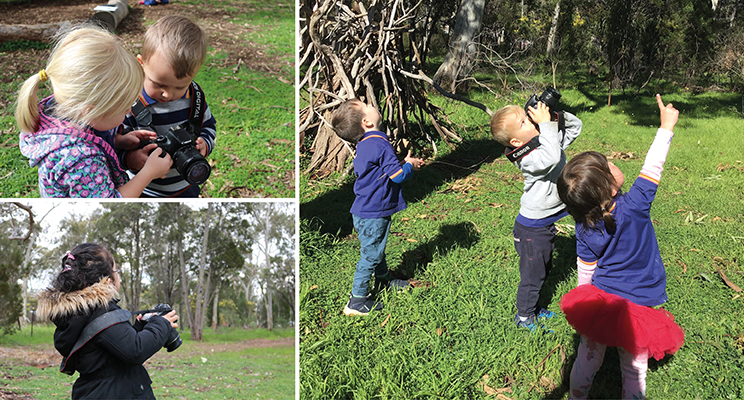
Since the beginning of the Term 3, the children and educators in Learning Community 1 have been learning about the native Australian birds we see in the natural spaces surrounding our ELC. Each day, we hear their songs in the background of our setting, and we see the birds eating our crumbs after morning tea, but what else are we noticing? What do we wonder about these birds? Where do the birds go when we don’t see them?
We took to Ferguson Park with our ‘special teacher’ DSLR cameras as an intentional tool to help us find out more about the birds we share our spaces with. We can always hear the birds in Ferguson Park, but they can be difficult to see. Through the use of the DSLR camera, our intention is to use many of our senses to notice; through listening, watching, waiting and capturing. The DSLR camera offers a more considered experience; we must coordinate, balance and focus this tool for the outcome to be effective. The DSLR cameras do not create the same ‘instant result’ that an iPad does. We must be patient, persist and help each other.
Naturally, our bird watching has become a group experience. Our small groups of photographers are moving together in the park, sharing in the joy of sighting magpies, galahs, rainbow lorikeets and cockatoos together. Upon returning to the Stonyfell and Bell Yett Rooms, we have been sharing the photographs that have been taken, and have used them as a tool to support our story telling. Our favourite thing that we have found out about birds through photography is that rainbow lorikeets always move with their friends and are never alone!
We have extended our learning about the different native Australian birds in the ateliers of both rooms, representing our knowledge through the mediums of drawing, painting, clay and creation with loose parts. Many of our bird creations were proudly displayed at the opening of the ELC Community Garden.
Annabelle Redmond
Learning Community 2
News from the Ferguson Room
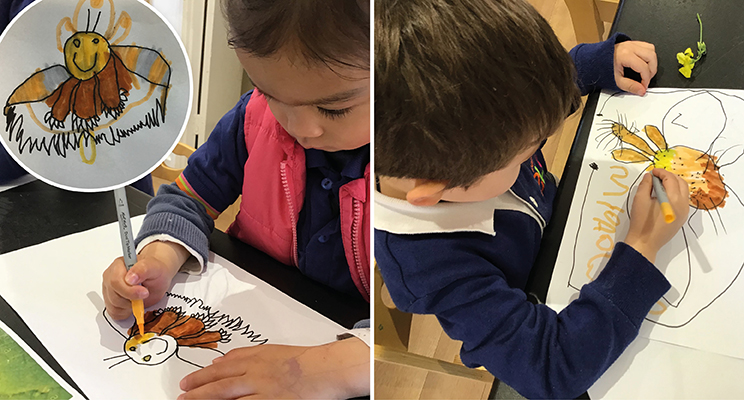
The caterpillar has transformed – our ELC Community Garden journey continues
Over the past few weeks, the children have begun to notice the disappearance of our beloved caterpillars; the numbers have dwindled and only a few scarce creatures remain.
We have begun wondering where they have gone. The answer to most children was plain, simple and straightforward. They must have become butterflies and flown away.
Uncertain with this theory, we saw the possibility to challenge this thinking and we proposed to the children this question:
Do all caterpillars transform into butterflies?
This question has fuelled our project and, during the past few weeks, we have been undertaking a range of research in order to find out the answer to this question.
The first thing we needed to research was what species of caterpillar have we found in our ELC Community Garden?
We tried many searches on the computer, however, only discovered that the type of caterpillar was part of a group of caterpillars known as loppers; this is due to the movement their body makes when they walk. Who could we ask? A scientist might know? We consulted with Miss Caterina’s husband, Claudio. He works as a biologist and, in consultation with his colleagues, they were able to determine the caterpillars are ‘Pine Loppers’. Their scientific name is Chlenias Zonaea. This type of caterpillar, however, does not become a butterfly; it becomes a moth.
This news was a revelation and it challenged us and our previous thinking about the process of metamorphosis and all caterpillars transforming into butterflies. The children however remained positive and were excited to then find out the difference between a butterfly and a moth.
We visited the library and borrowed several books on insects. We have also begun exploring several scientific images of these moths. The children have been sharing their own knowledge of moths and it has been determined that most moths are nocturnal.
“This means they come out in the night time and sleep in the day time.” – Evie
We have found out that our moth, the Chlenias Zonaea, is indeed nocturnal and this is why we have not seen them in the garden. With the support of Miss Caterina, the children have been creating their own scientific representation of the moth.
We are continuing our research together and the children are eager to find out more information about moths.
Laura Reiters
News from the Hallett Room
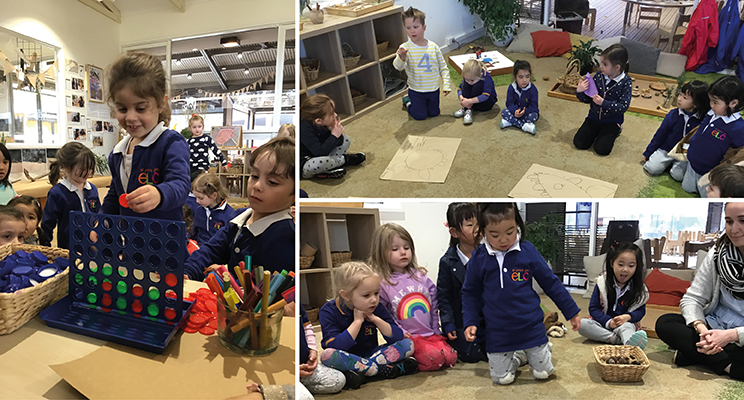
Co-constructing Culture can Develop and Sustain Communities
This idea has been central to our inquiry this term. Alongside the children, we have been exploring the values that underpin our learning community. Our ELC Community Garden has been the vehicle for initiating sustainable practices as we establish our worm farms to supplement the garden.
The children’s deep relationship with Kaurna culture has been apparent as they have shared their theory that the caterpillars in our ELC Community Garden are ‘Kaurna caterpillars’ because they lived in the garden first. When we observe connections such as this, we know that these values have become embedded in our culture.
Our rituals reflect our culture and make our values visible. Every day, we come together as a community of learners. We use Kaurna language with the children as we sit together in a Palti Circle and engage in our Ban Ban Balya. The children record their presence in our meeting by using either the Kaurna symbol for girl or boy, or creating a symbol of their own. We began to wonder if there was a more sustainable way of recording this, rather than the traditional paper and pen method we have been using.
We offered the children this provocation and began investigating other ways of recording. This continued for several weeks, with the children deciding at each Ban Ban Balya if we should record using pen and paper or with reusable materials. Eventually, the time came to decide which was the best method.
As educators, we value children’s agency and their right to have a part in making decisions that affect them, so we invited the children to vote. They placed a red counter if they wanted to draw the Palti Circle and a green counter if they wanted to make the Palti Circle using materials.
As is often the way, we have been surprised by their choices and left with more questions than answers. Despite our focus on sustainability, many children are voting to continue using paper. What does this mean? What does their desire to draw a symbol tell us? How can we support sustainable thinking that will become embedded in our culture? We welcome your thoughts.
Nell Tierney and Leanne Williams
